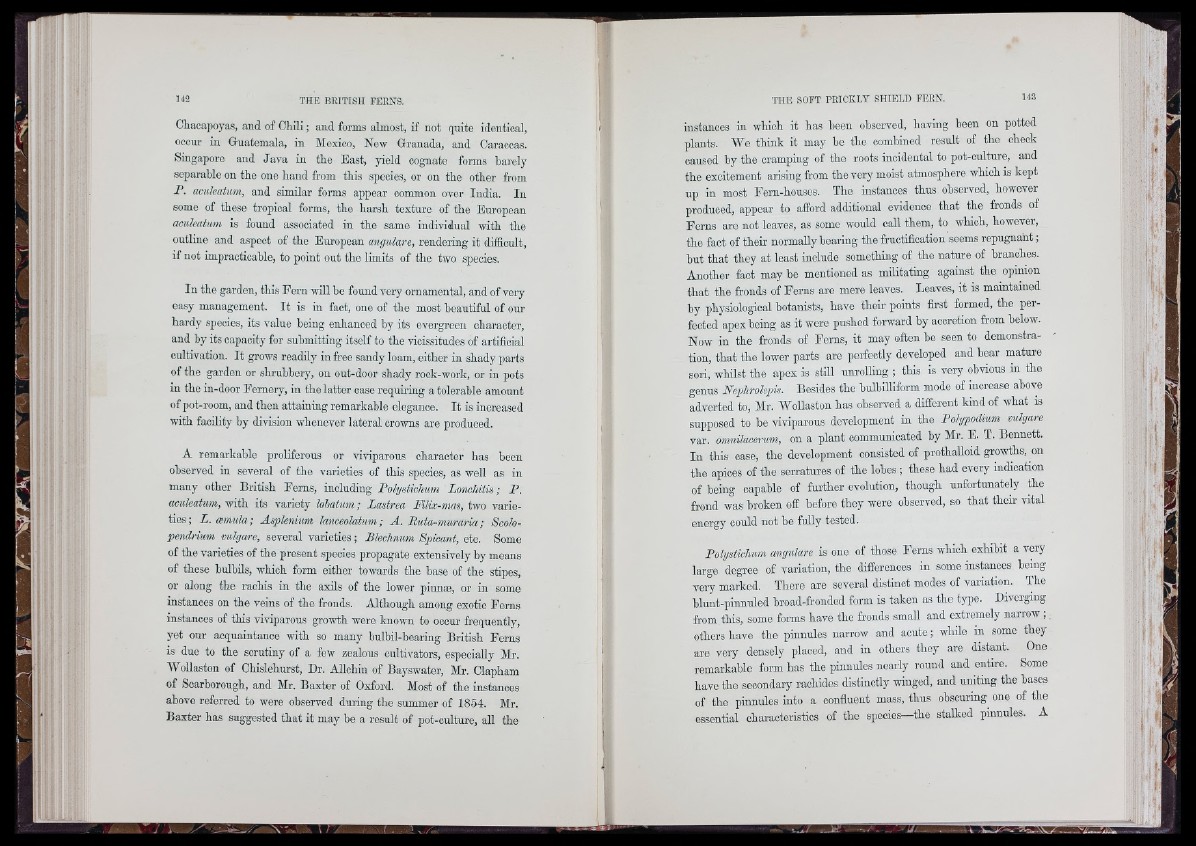
I. ■ f : ■
l i .
Chaoapoyas, and of Chili ; and forms almost, if not quite identical,
occur in Guatemala, in Mexico, New Granada, and Caraocas.
Singapore and Java in the East, yield cognate forms barely
separable on tho one hand from this species, or on the other from
F. aculeatum, and similar forms appoar common over India. In
some of these tropical forms, the harsh texture of the European
aculeatum is found associated in tho same individual with the
outline and aspect of the European angulare, rendering it difficult,
if not impracticable, to point out the limits of the two species.
In the garden, this Fern will be found very ornamental, and of very
easy management. I t is in fact, one of the most beautiful of our
hardy species, its value being ouhanocd by its evergreen character,
and by its capacity for submitting itself to the vicissitudes of artificial
cultivation. I t grows readily in free sandy loam, either in shady parts
of the garden or shrubbery, on out-door shady rook-work, or in pots
in the in-door Fernery, in the latter case requiring a tolerable amount
of pot-room, and then attaining remarkable elegance. I t is increased
with facility by division rvhenever lateral crowns are produced.
A remarkable proliferous or viviparous character has been
observed in several of the varieties of this species, as well as in
many other British Ferns, including Polysticlmm Lonchitis; P.
aculeatum, with its variety lohatum; Lastrea Filix-mas, two varieties
; L. mmula ; Asplenium lanceolatum ; A . Ruta-muraria ; Scolc-
pendrium vulgare, several varieties ; Bhchnum Spicant, etc. Some
of the varieties of the present species propagate extensively by means
of these bulbils, which form either towards the base of the stipes,
or along the rachis in the axils of the lower pinnæ, or in some
instances on the veins of the fronds. Although among exotic Ferns
instances of this viviparous growth were known to occur frequently,
yet our acquaintance with so many bulbil-hearing British Ferns
is due to the scrutiny of a few zealous cultivators, especially Mr.
Wollaston of Chislehurst, Dr. Allchin of Bayswater, Mr. Clapham
of Scarborough, and Mr. Baxter of Oxford. Most of the instances
above referred to were observed during the summer of 1854. Mr.
Baxter has suggested that it may be a result of pot-oulture, all the
instances in which it has been observed, having been on potted
plants. Wc think it may ho the comhinod result of the check
caused by tho cramping of the roots incidental to pot-oulture, and
the excitement arising from the very moist atmosphere which is kept
up in most Fern-houses. The instances thus observed, however
produced, appear to afford additional evidence that the fronds of
Ferns aro not leaves, as some would call them, to which, however,
the fact of thoir normally bearing the fructification seems repugnant;
but that they at least include something of the nature of branches.
Another fact may ho mentioned as militating against the opinion
th a t tho fronds of Ferns aro mere leaves. Leaves, it is maintained
by physiological botanists, have their points first formed, the perfected
apex being as it were pushed forward by accretion from below.
Now in the fronds of Ferns, it may often he seen to demonstration,
th a t the lower parts are perfectly developed and hear mature
sori, whilst the apex is still unrolling ; this is very obvious iu the
genus Neplirolepis. Besides the bulhilliform mode of increase above
adverted to, Mr. Wollaston has observed a different land of what is
supposed to be viviparous development in the Polypodium vulgare
var. omnilacerum, on a plant commnnioated hy Mr. E. T. Bennett.
In this case, the development consisted of prothalloid growths, on
the apices of the serratures of the lobes ; those had every indication
of being capable of further evolution, though unfortunately
frond was broken off before they were observed, so that their vital
energy could not he fully tested.
Polysticlmm angulare is one of those Ferns which exhibit a very
large degree of variation, the differences in some instances being
very marked. There are several distinct modes of variation. The
blunt-pinnulod broad-fronded form is taken as the type. Diverging
from this, some forms have the fronds small and extremely narrow ;
others have the pinnules narrow and acute; while in some they
are very densely placed, and in others they are distant. One
remarkable form has the pinnules nearly round and entire. Some
have tho secondary rachides distinctly winged, and uniting the bases
of the pinnules into a confluent mass, thus obscuring^ one of the
essential characteristics of the species—tho stalked pinnules. A